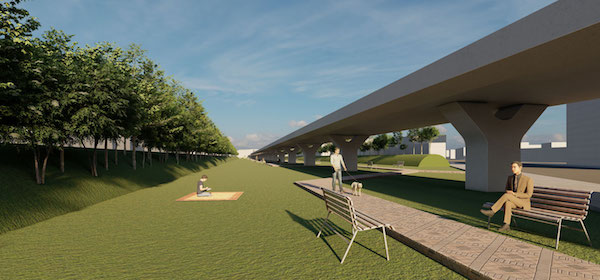
QueensLink rendering
The Rockaway Beach Branch right-of-way is a 3.5-mile, skinny strip of land that holds the key to transforming our borough in two fundamental ways. First, it will connect north and south Queens with the rest of the city in an environmentally sustainable way. Second, it will create up to 33 new acres of park space adding value to local neighborhoods and the entire city.
This dual-purpose project is called QueensLink.
It was disappointing to read “A Greenway for Queens” (December 5), where the authors continue to deny the need for better transportation. While the Manhattan-based Trust for Public Land apparently believes Queens doesn’t need more transit, riders and residents, who face some of the longest commutes in the nation, would disagree.
The QueensLink would bring travel time from Howard Beach to Midtown Manhattan down from over an hour to 45 minutes as well as create faster trips throughout the borough and to Brooklyn.
The authors repeat the myth that new transit and new parks can’t be built along this corridor, but this belies the simple fact that in most other places using land for both uses is common. In Oakland, CA, the BART system was built along an old freight rail line that was converted to rapid transit with land at ground level used for a parkway. Miami, Vancouver, Boston, and Atlanta have all incorporated parks along their transit lines. QueensLink would create up to 33 acres of new park space connecting north and south Queens.
Queens has 2.3 million inhabitants but the fewest subway miles per resident of the four boroughs with subway access. Roads like Woodhaven Boulevard. and Van Wyck Expressway are constantly congested while buses are overcrowded and average just 8–10 mph. Subways are the fastest, cleanest, and most efficient way to move many people great distances.
While adding a modest 3.5 miles to the system, the value is most apparent in the connections the QueensLink offers. Finally, riders could get from north to south Queens on one train without having to ride through Manhattan and Brooklyn. Brooklyn riders could access jobs in Queens more easily. The QueensLink would connect to every east-west transit line in Queens to offer the most options for commuters.
The status quo of pitting two sides against one another so nothing is ever done has to end. At this critical juncture in our borough’s history we need individuals and organizations that will rise above the NIMBYism of the last generation. We need thought leaders and elected officials with vision and the courage to advocate for projects that achieve the greater good rather than continue to protect the narrow interests of the well-heeled and well-connected few.
When you have a valuable public asset like the Rockaway Beach Branch right-of-way it is crucially important to analyze what use or uses represent the greatest public good. We have one shot at getting this right, so let’s take an objective look at that question and see where the facts lead us.
The MTA released its long-delayed Rockaway Beach Branch reactivation study last month and the conclusions were gratifying. The MTA determined that reactivating the line as a subway from Queens Blvd., Rego Park to Howard Beach, JFK Airport was feasible. The study also determined that 47,000 riders a day would use the line, a conservative figure since it does not include connecting passengers.
Much of the extra costs included by the MTA were due to their extended projected construction schedule of ten years that should take no more than two to three. While the total MTA number associated with the project was $8 billion, the hard construction costs are about $1.6 billion. Experts have estimated that a design-build approach should result in a total cost of about $2 billion. Still a formidable number but a more realistic one.
Even with lower costs, building the rail and park will require thinking outside the box. QueensLink is developing a new funding strategy that incorporates transit-oriented development and value capture through a public-private partnership.
QueensLink takes inspiration from the LIRR Third Track, a large rail infrastructure project that, like the Rockaway Beach Branch, was bogged down by small thinking for decades. Now this $2.6 billion, 9.5-mile project is underway and on-time and on-budget. Local communities along the rail played a big part in the planning and design, which ultimately led to its success.
QueensLink represents an investment in transit equity that will help people reach education, employment, and recreational opportunities that were out-of-reach before. It is also fully aligned with city and state environmental initiatives to reduce congestion on our roads and the carbon emissions that come with it.
Queens is now at the crossroads. The borough’s residents and elected officials will soon have to decide if we will rise to the challenge of working together for our common good or against each other to our common detriment. The good news is that we don’t have to decide between a rail and more green space, a well-designed QueensLink can and should provide both.
***
Rick Horan is the Executive Director of QueensLink and Andrew Lynch is the Chief Design Officer. On Twitter @thequeenslink.
***
Have an op-ed idea or submission for Gotham Gazette? Email This email address is being protected from spambots. You need JavaScript enabled to view it.




